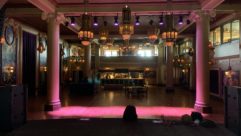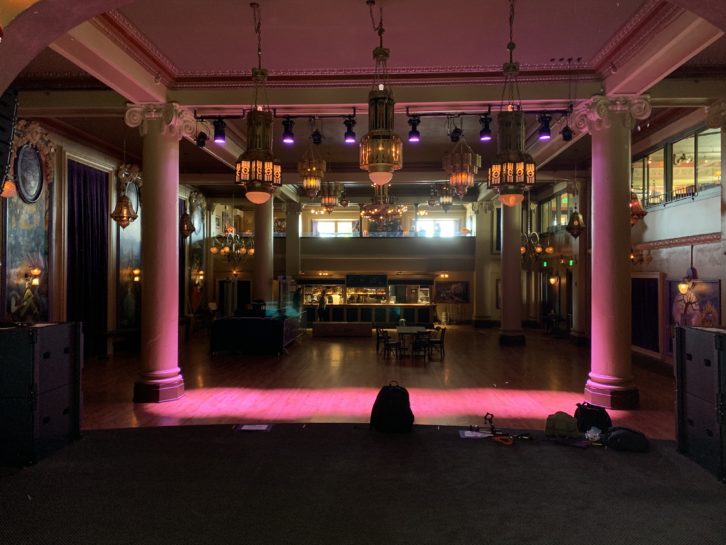 On this edition of the SVC Podcast, Contributing Editor Bennett Liles finishes his conversation with Nick Moon, owner of Tone Proper AV in Portland. Oregon about their installation of an all new sound system for McMenamin’s Elks Temple Spanish Ballroom in Tacoma, Washington. Nick recalls the difficulty in hauling many items of pre-assembled sound gear up the stairs because the building has no loading dock and did not have a working elevator at the time. He also discusses the setup including EQ and presets.
On this edition of the SVC Podcast, Contributing Editor Bennett Liles finishes his conversation with Nick Moon, owner of Tone Proper AV in Portland. Oregon about their installation of an all new sound system for McMenamin’s Elks Temple Spanish Ballroom in Tacoma, Washington. Nick recalls the difficulty in hauling many items of pre-assembled sound gear up the stairs because the building has no loading dock and did not have a working elevator at the time. He also discusses the setup including EQ and presets.
FOR MORE: GO TO PART 1
Links:
- Midas Pro2-CC-IP digital monitor mixer
- Bose ShowMatch speakers
- ACE sound equipment for musicians
- Bose Modeler sound system software
Transcript-
After renovating and fitting out Portland’s Crystal Ballroom, Tone Proper Audio and Video got the chance to make the same miracle transformation for McMenamin’s Elks Temple Spanish Ballroom in Tacoma. They took on the job and came up with a top flight sound system in the middle of a classical building. Tone Proper AV owner Nick Moon is back to give us the rest of the story on how they made it all happen.
Nick, good to have you back with us from Tone Proper Audio and Video in Portland. We were getting into the sound system for McMenamin’s Elks Temple Spanish Ballroom in Tacoma that you modeled after the one you did for Portland’s Crystal Ballroom. Can’t wait to hear more about it.
Thanks for having me.
The Spanish Ballroom was not only completely gutted for the renovation and a complete start-over but it was also not an easy place to get all the sound gear into. They have no loading dock and a lot of this equipment was pre-assembled.
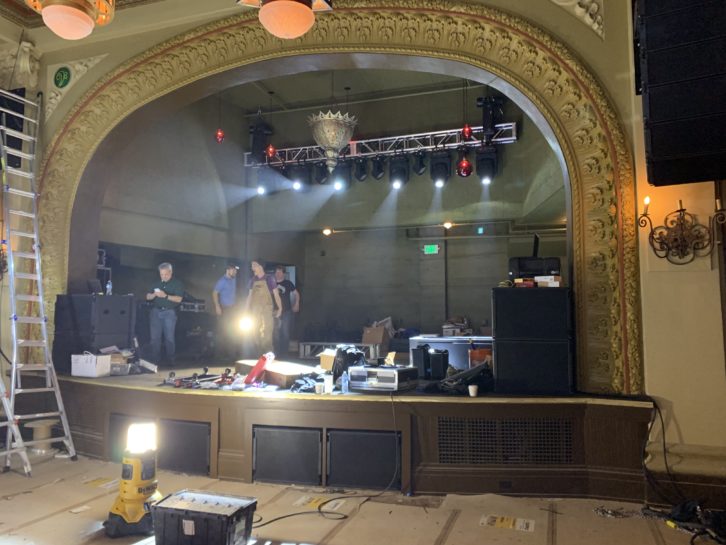
Yeah. We typically do a lot of the stuff here at the shop. Racks and all that stuff we build and test on site so that we can show up and we kind of know how it’s all going to get together. In this case this building, it was an old building that’s been restored and so there was no elevator. So they added an elevator and the elevator wasn’t operational during our load-in. Plus the Spanish Ballroom is on the second floor I think it is and so we basically had to carry the entire PA, which was I don’t know how many thousand pounds, upstairs. So we had 12 18’s plus the main array, array frames, amplifiers, wedges, everything had to be carried so that was pretty exciting. I got a good workout that day. But they do have an elevator now that’s working at the space. But yeah, basically we build everything, the wiring assemblies and everything, ahead of time so that when we get there we just need to fly the system and plug it in. We had to condense it down quite a bit in order to make it so you could actually physically move it because if you can imagine a 42U server rack full of distro and amplifiers, I mean even with four or five people, I mean it’s just not something you can move without destroying stairs and all that stuff. So we actually whittled it down to a 32U rack and then a couple of sub assembly racks that had the power, the distro and that kind of stuff in it so it was easier to move around. And in the long run I think it was the smart way to go, too, because things are a little bit more modular, which is nice. [Timestamp: 2:32]
Well, it sounds like that could have been good for a few hernias just getting everything in there.
Yeah. Yeah. Yes it was.
When you started setting it up what main house speakers did you use on this?
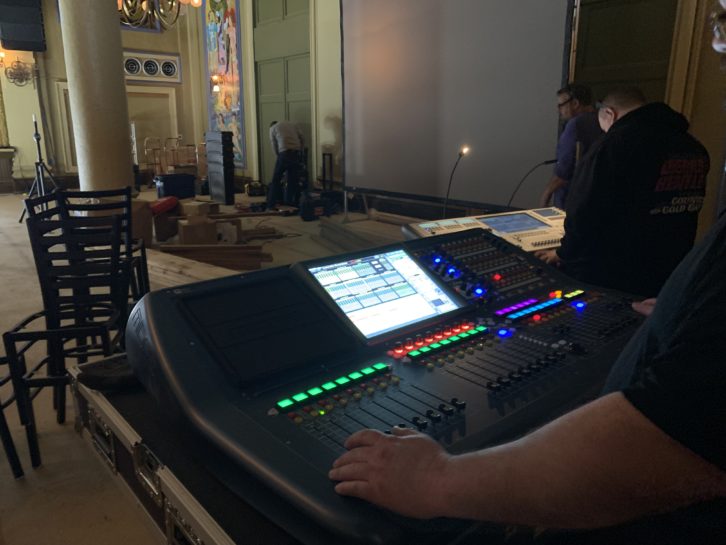
So this is Bose ShowMatch system and the subs are also the ShowMatch. [Timestamp: 2:47]
And so how did you get all the amps and the speakers connected? How close in proximity were they?
The main amp rack is just on side stage so it wasn’t a real far run. Each module is bi-amped so there is a lot of wire looms going up there and each sub has got its own direct line as well. So it was a fair amount of wiring but nothing too crazy. [Timestamp: 3:10]
And so for control what type of front of house mixer have you got in there?
So it’s a PRO2 and a PRO2C at Monitor World. And from being an audio guy, the Midas Pro Series stuff sounds really, really good and the ShowMatch sounds amazing. That is one of those systems that you run your tuning file if you design it well in Modeler, run the files, turn it on, you’re 95 percent there. It sounds really, really good. And then we typically follow that up with Smart. We’ll do some tuning with Smart and verify that everything is aimed correctly and doing what it needs to be doing. And then we’ll just do some minor tweaking and then save that into the processor and lock that up. And then the front-of-house guy, from his console, still has a graphic he can do or she can do. But it basically gets us to a really good starting point so that they can do whatever they need to do or they feel that they need to do for the system or for the type of music or anything like that. [Timestamp: 4:07]
Now the Spanish Ballroom in Tacoma and the Crystal Ballroom in Portland, these can actually support each other because the performers play one and they can save their setup on USB and plug it right in at the other place.
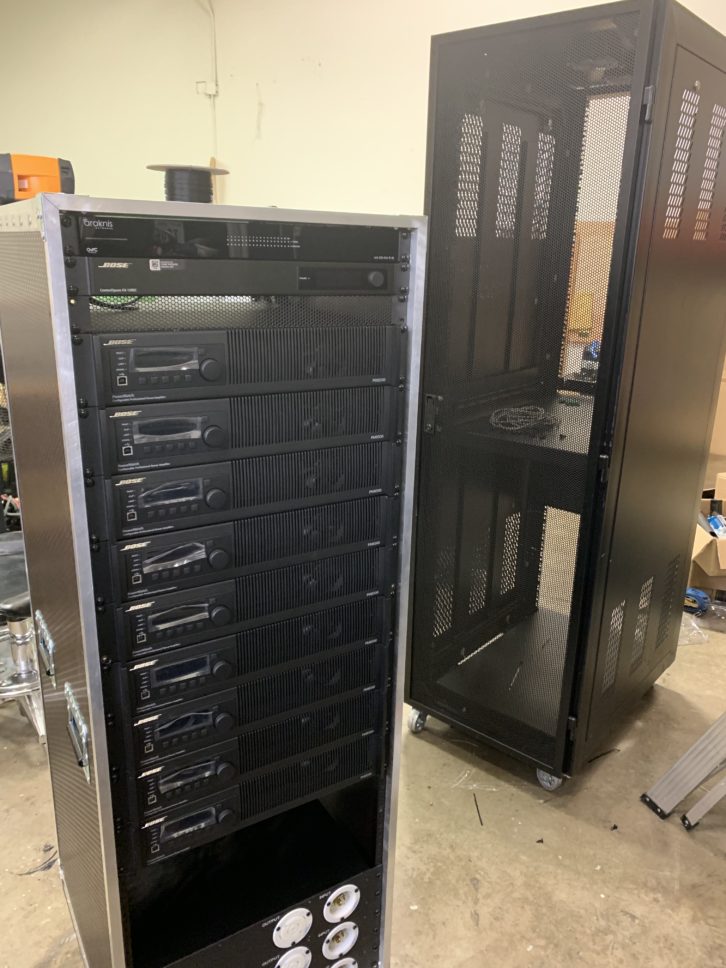
Yeah. The consoles are the same, the split is the same. Most of the microphones are the same. The only difference is the Crystal is a larger room so that’s a larger rig. We’ve got 12 18’sin that one in a distributed kind of arc of sub so there’s a lot of low-end available there. But because the Spanish Ballroom is also hotels and bars and everything else we have a pretty strict limit on output so we’re really not pushing it nearly as hard as the Crystal Ballroom gets pushed. But it’s definitely there if they wanted it. But yeah, the point being that you could do a show at the Crystal Ballroom and be very close at the Spanish Ballroom with those files. [Timestamp: 4:58]
And what was it like getting all of that balanced with the EQ and the presets? How long did the operational setup take to get all done and ready to use?
Very, very short because we do a lot of that engineering work ahead of time. So all the files were built for all the amplifiers. We had schematic drawings for everything. And then all the turning files were built so all of the amplifiers and processors were already preconfigured, labeled and already known to what amplifier is driving what set of low frequency or high frequency drivers. And we use Ace Backstage and RCI a lot to do custom face plates. So we’ll build a 6 or 8U face plate with a bunch of NL4’s on the back that will have house left speakers 1 and 2 and then house – and go down the line – or Sub 1 and Sub 2. So then we pre-solder and hardwire all of that to the amplifiers on the back of the rack so that when you get there all you’ve got to do is flip it on and plug in a cable to the array. We do that for a couple of reasons: 1. It’s very reliable. It’s very easy for anyone with a flashlight to look back there and say, “Oh, okay. This is where each thing is going.” It’s a very simple swap to fix a problem, know where it is and all of that. So those are the kinds of things that don’t cost a whole lot more but make life in a challenging, dark, loud and noisy environment much, much more effective. [Timestamp: 6:25]
Yes and I saw that the Spanish Ballroom has a very early Twentieth Century classical appearance. Meticulously restored and that’s got to be part of the allure of this place for performers and their audiences. That could be a challenge on the acoustics so do you tend to find tougher acoustics in older restored buildings than in the modern steel and concrete venues?
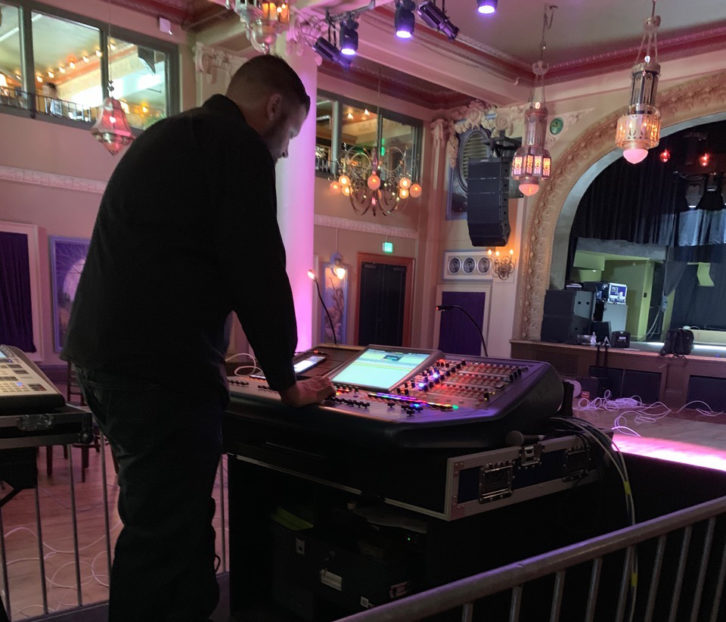
No. You know what? I don’t think so because we do a lot of new construction houses of worship as well and in order to save money it’s steel buildings or concrete and steel. I’ll take wood any day over older concrete and steel. So all that to be said there is kind of a charm of these older buildings that are kind of neat, but walking into a room that’s concrete and steel new construction where they haven’t budgeted for any acoustical treatment is really a problem. [Timestamp: 7:14]
I would have thought that might be the other way around but now that you mention it when it’s a brand new building they might not be that eager to make any changes to accommodate what you may want to do on the sound setup. How long did you have to do the whole job and get it ready to use?
For the Spanish Ballroom we had a lot of time because the construction took a long time. It was maybe six months or something like that. So we already know what we were going to do months, months, months in advance so then it was just a matter of when we got close ordering everything up and start assembling the racks and cable assemblies and all that kind of stuff and getting all the equipment in. So we had plenty of time and we definitely didn’t feel rushed at all. Obviously when the install comes you don’t want to install it too soon because they’re just going to get dusty and dirty with all the construction going on. And you don’t want to do it too late so if something happens you’re up against the opening date. I think we did it about five days or four days before the opening so we knew that it would take a couple of days and then maybe a day of commissioning and tuning and then we’d have a couple days’ buffer. And I think we used all of it so I think that’s how that went down. [Timestamp: 8:16]
Who were the test subjects, the first performers to use this and how did they get along with it?
I think the opening night was a couple of different bands. We did have a little bit of an issue under the stage when we were pulling network cables. One of the network cables that feeds the DL251, which is the input/output box for the Midas’, got wrapped around some of the cams that feed the power distro. So each one of these cams is 100 amps of electricity and so you can kind of guess what happened there. They were starting to get some drop outs and we couldn’t figure it out. Went underneath the stage with a headlamp and saw one of those network cables was all entangled with all the power cables. And so we just kind of resorted that out and that was fine. So that was really the only snafu that we had, actually, and I consider that kind of a win because [Laughs] we did a lot of moving parts and lots of things can go wrong. So we had four or five days and it went really well. [Timestamp: 9:12]
Well, that’s great. It’s good to know everything went OK on that one. I know Tone Proper AV has more things going on so what projects do you have coming up or in progress now?
This time of year, in the summer, is lots of church renovations. It seems like a lot of churches, it’s summertime so people are gone, attendance is lower, so this is the time to get some construction done to get ready for fall serious and stuff like that. So we have three churches under construction right now that we’re doing all the AVL for and we’ve got two video walls going in, sound systems and lighting. Just lots of upgrades in various sizes and shapes. We have a Catholic church using the new MSA series of digital beams steering stuff from Bose. We’ve got a couple of big Fulcrum installs going in and so definitely a busy season right now. And then by fall no one will know we exist. It’ll be great. [Laughs].
Well, it’s been very good of you to get with us and tell us about this one. An absolutely fascinating place. And it was perfect having you provide some really interesting images of the installation work in progress.
Yeah, yeah.
It’s Nick Moon from Tone Proper Audio and Video in Portland, Oregon and the complete renovation and sound system install for McMenamin’s Elks Temple Spanish Ballroom in Tacoma. Great hearing about it.
Thanks, and I appreciate being on.
First-rate sound in a classical venue. Tone Proper AV braved the stairs and got this beautiful place ready to serve all occasions. Next week we’ll have another AV installation project to explore so be right here for that on the next SVC Podcast. See you then.



